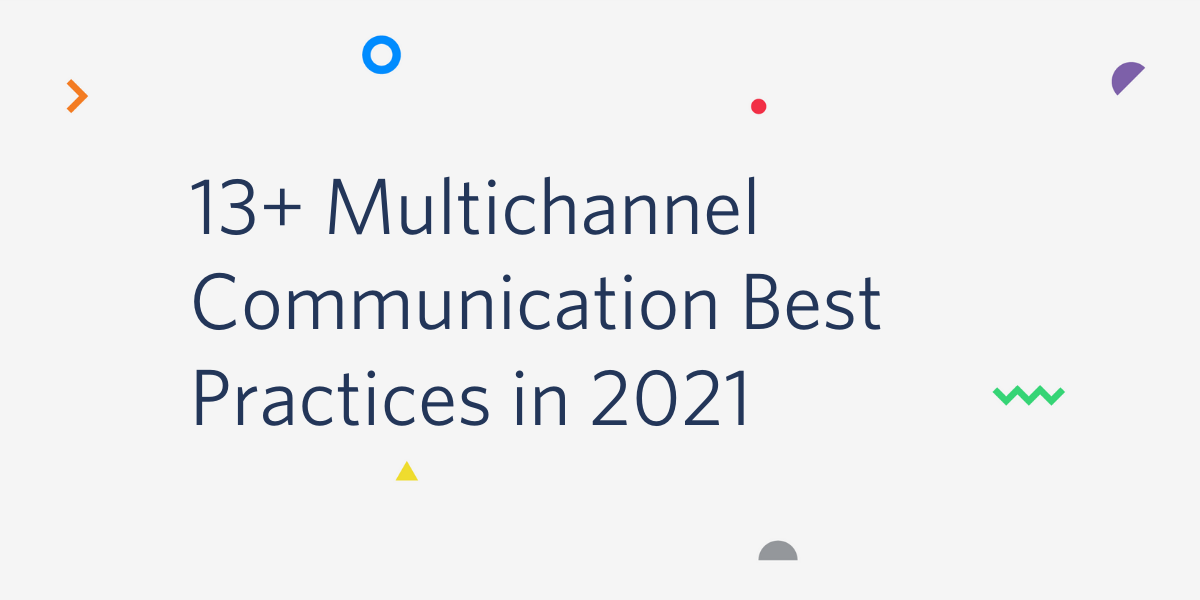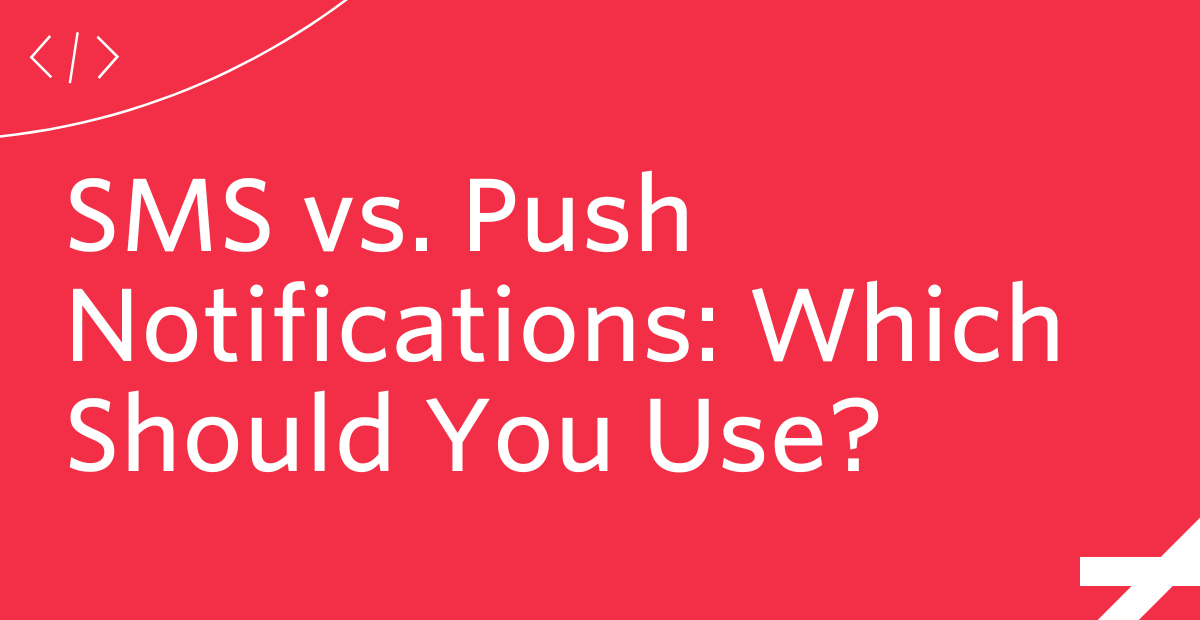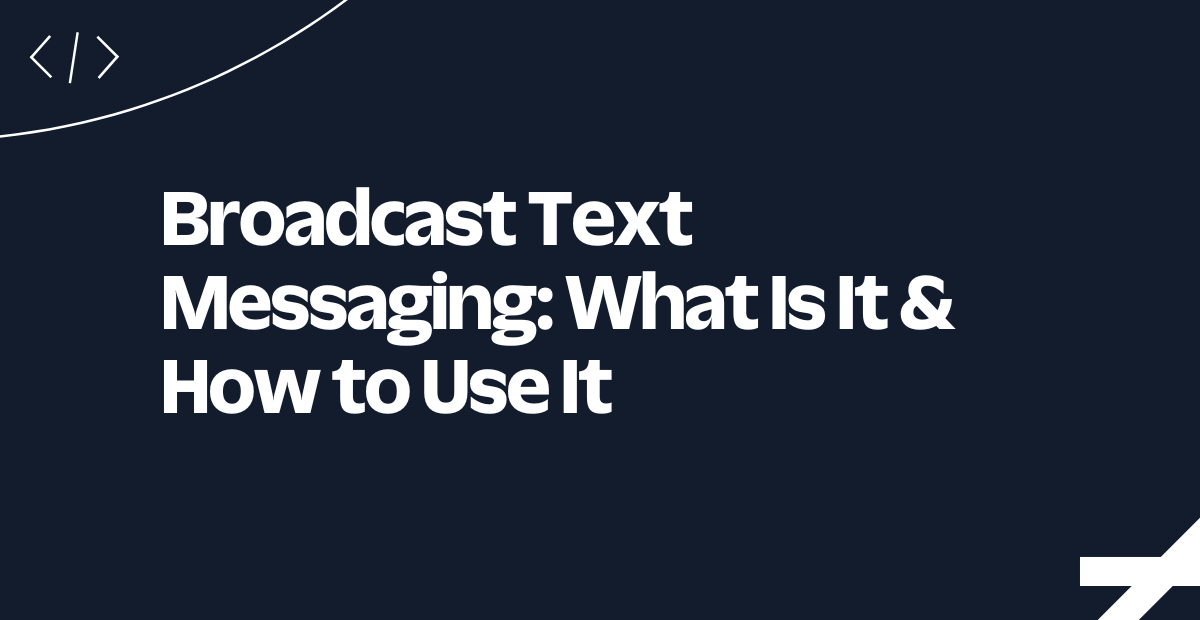13+ Multichannel Communication Best Practices in 2021
Time to read:

Communication doesn’t happen in a vacuum. Your customers see messages from brands all day, every day. From the ads on TV to the related products on the cereal box to the emails in their inbox—it’s non-stop.
When you send your customers an email, shoot them a text, or give them a call, that’s likely not the only communication they’re getting from your brand. They likely saw your Instagram post or blog article, and there’s a good chance you’re retargeting them with pay-per-click (PPC) ads across the internet.
It’s a lot.
Communicating with your customers across multiple channels isn’t a bad thing—far from it. However, if you fail to follow best practices, you risk damaging your brand reputation and alienating (or flat-out annoying) your audience.
Previously, we’ve published email marketing, surveying, video, calling, and SMS best practice guides. But now, we’re going to share our top multichannel communication best practices. Below, we’ll walk you through things you need to consider when creating a holistic marketing and communication program.
What is multichannel communication?
Multichannel communication is exactly what it sounds like—communication across multiple channels. These channels could include:
- SMS
- Voice
- Video
- Social networks
- Facebook Messenger
- PPC
- Influencer marketing
- Event marketing
- Offline marketing
And that’s just the beginning.
If you send your subscribers an email newsletter and text appointment reminders, you’re engaging in multichannel communications.
Multichannel communication vs. multichannel marketing
Multichannel communication is often used interchangeably with multichannel marketing. While the terms don’t mean exactly the same thing, they both describe a business using multiple channels to reach its audience.
Multichannel marketing typically refers to marketing-related messages, such as product emails, holiday sale reminder texts, PPC ads, and social media advertisements. Multichannel communication refers to other nonmarketing-related messages, such as shipping notifications, customer support assistance, and business announcements.
Guidelines for multichannel communication
If you’re already following all the best practices for each of the channels you use, is following a bunch of new multichannel communication best practices really necessary?
Yes, adhering to channel-specific best practices should be your top priority. However, if you fail to follow these multichannel guidelines, here’s what you may experience:
- Customer fatigue: Customers can feel bombarded by your messages, and they may choose to unsubscribe or ignore future attempts.
- Inadequate communication: When you’re firing communications on all cylinders, it can be easy to think someone else will take care of it. Some messages might not get communicated while others get overcommunicated.
- Messaging inconsistencies: Without multichannel communication best practices in place, your messaging and brand could be out of sync across different channels. Some channels may communicate messages that contradict another channel’s messaging. For example, one might promote a 10% off deal while another shares a 20% off deal.
- Branding hiccups: When channels go unchecked, sometimes branding issues can happen. Channels may use outdated assets, speak in an off-brand voice, or use the wrong brand colors.
- Duplicative communications: While repetition helps with adoption, sometimes it’s overkill. For example, if you market a brand-new pair of shoes to a customer, you should stop advertising those shoes to them once they make the purchase.
All these things can ruin customer loyalty and ultimately hurt your bottom line. Fortunately, they’re all preventable. Follow these 15 multichannel communication best practices to improve your business messaging.
13+ multichannel communication best practices
1. Use channels your customers want
When organizing your communications program, take time to learn about your customers and consider what they want. Don’t just launch an email marketing and SMS program because that’s what your competitors or other players in your industry are doing—talk to your customers to see what channels they’re using.
For example, you might find your customers don’t want a phone number to call, but they do want a chat option on your website. You also might find that your paying customers spend more time on Instagram than Facebook, and that can inform where you allocate your marketing budget.
In the end, you can’t realistically be everywhere—you’ll need to prioritize the right channels. If your audience is on Reddit and Stack Overflow, you might need to spend your time building a presence there rather than building a Pinterest or TikTok following.
Here are a few popular channels to consider:
- Social networks
- Text
- Voice
- Video
- Push notifications
- Chat
- Facebook Messenger
2. Learn everything there is to know about your customers
While you’re learning about which channels your customers use, take time to learn deeper insights about them. Learn their wants, needs, fears, desires, aspirations—learn what makes them happy and what makes them upset.
Use this information to create different buyer personas. Not all your buyers will look the same, and you’ll need to communicate to each persona to make the sale. Take Nike footwear, for example. Nike caters to professional athletes, weekend warriors, and everyday recreationists—they can’t use the same general messaging for all these target personas.
Once you’ve created buyer personas, create targeted messaging that’ll resonate with each of the audiences. Next, figure out where this persona spends their time online. This will help shape your messaging strategy.
For example, if you’re marketing to developers and designers, you might tailor your messages to developers on Reddit and Twitter differently than you craft your messages for designers on Instagram and Pinterest.
3. Don't overwhelm customers
When evaluating your communications program, think about how many touchpoints a customer might have with your brand in a single day or week.
Instead of hitting them with an email, text message, sponsored LinkedIn post, and PPC ad all in a single day, consider spacing out your communications. Coordinate with your SMS marketing specialist to ensure your email and SMS campaigns go out on separate days, and talk to your social media manager to guarantee targeted social messaging happens on off days from your email and SMS campaigns.
It might seem like a lot to coordinate, but it’s worth it. If your customers feel like you’re following them around the internet, they may opt out of your messaging to give themselves some breathing room. Be proactive and give them space before they unsubscribe or mark your messages as spam.
4. Consolidate your communications
It’s hard to align your communications program if it’s scattered across the internet. Use tools and software to consolidate your communications so you can see it all in one place (or as close to one place as possible).
For example, you could use a contact center like Twilio Flex. Flex lets you have 1:1 conversations with your customers across various channels, like WhatsApp, Facebook Messenger, SMS, voice, and WebChat. This gives all your agents complete visibility into a customer’s contact history, allowing you to create higher-quality experiences.
As for your social media engagement, consider using a tool to consolidate all your messaging and conversations. Tools like Hootsuite and Sprout Social can help you stay organized and data-driven.
5. Align your brand
Your brand should show up the same across every channel. Whether you’re sending text messages or emails, your customers should be able to recognize your brand’s logo, voice, colors, illustrations, buttons, and more.
Messaging and tone might show up differently across platforms, but it should still be a consistent brand experience. For example, if your brand is fun and light, you’d want to embrace that in your text messages and tweets. However, you might want to tone it back just a bit (while also still being true to you) on a more professional platform like LinkedIn.
Monitor your channels and profiles to ensure you’re always using up-to-date assets. If a logo changes or you have an overall branding shift, double-check every platform to make sure the change is consistent.
6. Take notes
Create a cohesive ongoing conversation with your customers. Every new interaction should build off the last, even if it’s on a brand-new channel. For example, if a customer contacts your customer support via phone call today, your team members should have updated notes on the customer if they submit a chat ticket next week.
Record your notes automatically or manually in a customer relationship management (CRM) tool. Whether it’s an email response, customer support call, chat window conversation, or a quick back-and-forth on WhatsApp, keep your records up to date.
Create a single view of each of your customers using Segment. Segment helps unify your customer’s touchpoints across different platforms and channels so you can better understand your customer’s journey.
7. Regularly review your analytics
Take time every month to check your analytics. Insights from your data can inform which channels are resonating best with your audience and which you should prioritize.
For example, if you’re seeing a high engagement rate through your email messages but low engagement through SMS, you might want to send important campaigns through email in the future.
Your analytics can also help inform the content you share across different channels. A post that’s getting above-average attention on Twitter might be a good link to share via an email newsletter, and it may make for an effective PPC ad, too.
8. Set benchmarks
Set goals and benchmarks for each of your communication platforms. Going through this practice will ensure you’re actively taking steps to improve (or maintain) your communication channels rather than just going with the flow.
Set goals for email open rates, SMS click-through rates, call center customer satisfaction scores, and social media engagement. Regularly check these metrics to see if you’re headed in the right direction. If not, pivot and make adjustments sooner rather than later.
9. Tailor your message to the channel
You shouldn’t be copying and pasting the same message across every channel. Your audience uses different channels in varying ways. Conversations on Twitter will be a bit different than an online chat, and those will be different than the email conversations and phone calls you have.
Tailor your message to the channel. Tweets will need to be shorter and more concise, while emails can be longer and more detailed. Chat windows will have a higher air of friendliness and helpfulness, while Instagram DMs can be a bit more casual and laid back.
10. Create messaging guidelines
One person likely won’t be handling your entire communications program. You might have a team handling email correspondence, a social media manager, a content marketing team, a demand generation team, and more. Create a communication guidelines document to keep everyone on the same page.
This document can outline message points, brand voice, messaging frequency, campaign scheduling, shared assets, point of contacts, and more. Keep this document updated and regularly sync with channel owners to keep everyone up to date.
11. Ensure your message is device responsive
Since you’ll be sending and receiving messages across mobile, desktop, and browser applications, ensure your messages are responsive and show up right on every platform. It’s easy to get into the mindset of copy/pasting your messages from one channel to another, but this can lead to messy formatting and rendering errors.
For example, when sending email messages, run your campaigns through a testing tool to check for broken links, spammy-looking content, and formatting issues. With Twilio SendGrid’s email testing tool, you can see how an email will show up across clients, browsers, and devices before you ever press "send."
12. Don't forget about nondigital communications
Multichannel communication isn’t limited to the digital world—it also includes offline marketing and communication materials. This could include:
- One-pagers
- Billboards
- Local advertisements
- Event marketing assets
- Direct mail
- Physical products and gifts
- Posters
- T-shirts
- Hats
Whenever you make a change to your messaging or branding, double-check your offline communications to ensure they stay current. Offline changes can be expensive, especially if you have a large inventory, so be intentional and thoughtful before you make any big changes.
13. Consider different channels
Don’t limit yourself to the classic marketing and communication channels. Think outside the box, as your developer may have a large Twitch following, while your CEO could have a significant LinkedIn presence. Learn to leverage personal channels (where appropriate), too.
Start your multichannel communication program
Starting, managing, and maintaining a multichannel communication program isn’t easy. Let us help. Twilio Flex is the world’s most flexible contact center platform, and it can help you serve customers through voice, SMS, WhatsApp, WebChat, and more from a single source of truth.
Whether you’re launching an email program, SMS campaigns, live streaming, or chat application, we have the tools you need. Sign up for free (no credit card required) and start building.
Related Posts
Related Resources
Twilio Docs
From APIs to SDKs to sample apps
API reference documentation, SDKs, helper libraries, quickstarts, and tutorials for your language and platform.
Resource Center
The latest ebooks, industry reports, and webinars
Learn from customer engagement experts to improve your own communication.
Ahoy
Twilio's developer community hub
Best practices, code samples, and inspiration to build communications and digital engagement experiences.


